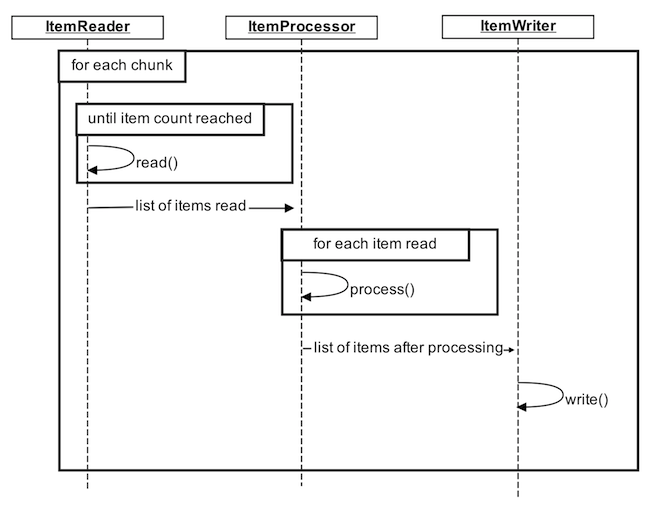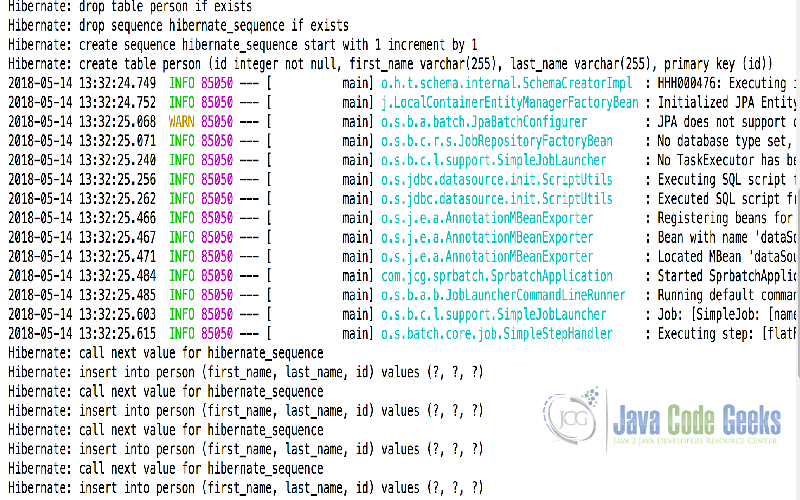1. Overview
- Spring Batch Flat File Item Writer Example Pdf
- Spring Batch Flat File Item Writer Examples
- Spring Batch Flat File Item Writer Example Free
- Spring Batch Flat File Item Writer Example Program
Spring Batch is a powerful framework for developing robust batch applications. In our previous tutorial, we introduced Spring Batch.
15-writing-items-to-db - writing items to a jdbc database source; 16-writing-items-to-fs - writing items to a flat file; 17-writing-items-to-xml - writing items to an XML file; 18-writing-to-multiple-files - writing items to multiple files/formats; Processors. 19-processing-basic - processing an item, basic example. Spring Batch provides readers and writers to read and write data form various file systems/databases such as MongoDB, Neo4j, MySQL, XML, flatfile, CSV, etc. To include a reader in your application, you need to define a bean for that reader, provide values to all the required properties within the bean, and pass the id of such bean as a value to. The following examples show how to use org.springframework.batch.item.ItemWriter.These examples are extracted from open source projects. You can vote up the ones you like or vote down the ones you don't like, and go to the original project or source file by following the links above each example. I have 2 writers db writer and file writer. In case of every record processed irrespective of conditions i need to save it to database. But only on certain codes i need to write it on flat file. I was thinking composite item writer but would really value your input. Thanks, my email address is tshah@egov.com. Clone via HTTPS Clone with Git or checkout with SVN using the repository’s web address.
In this tutorial, we'll build on the previous one and learn how to set up and create a basic batch-driven application using Spring Boot.
2. Maven Dependencies
First, let’s add the spring-boot-starter-batch to our pom.xml:
We'll also add the org.hsqldb dependency, which is available from Maven Central as well:
3. Defining a Simple Spring Batch Job
We're going to build a job that imports a coffee list from a CSV file, transforms it using a custom processor, and stores the final results in an in-memory database.
3.1. Getting Started
Let's start by defining our application entry point:
As we can see, this is a standard Spring Boot application. As we want to use default configuration values where possible, we're going to use a very light set of application configuration properties.
We'll define these properties in our src/main/resources/application.properties file:
This property contains the location of our input coffee list. Each line contains the brand, origin, and some characteristics of our coffee:
As we're going to see, this is a flat CSV file, which means Spring can handle it without any special customization.
Next, we'll add a SQL script schema-all.sql to create our coffee table to store the data:
Conveniently Spring Boot will run this script automatically during startup.
3.2. Coffee Domain Class
Subsequently, we'll need a simple domain class to hold our coffee items:
As previously mentioned, our Coffee object contains three properties:
- A brand
- An origin
- Some additional characteristics
4. Job Configuration
Now, on to the key component, our job configuration. We'll go step by step, building up our configuration and explaining each part along the way:
Firstly, we start with a standard Spring @Configuration class. Next, we add a @EnableBatchProcessing annotation to our class. Notably, this gives us access to many useful beans that support jobs and will save us a lot of leg work.
Furthermore, using this annotation also provides us with access to two useful factories that we'll use later when building our job configuration and jobs steps.
For the last part of our initial configuration, we include a reference to the file.input property we declared previously.
4.1. A Reader and Writer for Our Job
Now, we can go ahead and define a reader bean in our configuration:
In short, our reader bean defined above looks for a file called coffee-list.csv and parses each line item into a Coffee object.
Likewise, we define a writer bean:
This time around, we include the SQL statement needed to insert a single coffee item into our database, driven by the Java bean properties of our Coffee object. Handily the dataSource is automatically created by @EnableBatchProcessing annotation.
4.2. Putting Our Job Together
Lastly, we need to add the actual job steps and configuration:

As we can see, our job is relatively simple and consists of one step defined in the step1 method.
Let's take a look at what this step is doing:
- First, we configure our step so that it will write up to ten records at a time using the chunk(10) declaration
- Then, we read in the coffee data using our reader bean, which we set using the reader method
- Next, we pass each of our coffee items to a custom processor where we apply some custom business logic
- Finally, we write each coffee item to the database using the writer we saw previously
On the other hand, our importUserJob contains our job definition, which contains an id using the build-in RunIdIncrementer class. We also set a JobCompletionNotificationListener, which we use to get notified when the job completes.
To complete our job configuration, we list each step (though this job has only one step). We now have a perfectly configured job!
5. A Custom Coffee Processor
Let's take a look in detail at the custom processor we defined previously in our job configuration:
Of particular interest, the ItemProcessor interface provides us with a mechanism to apply some specific business logic during our job execution.

To keep things simple, we define our CoffeeItemProcessor, which takes an input Coffee object and transforms each of the properties to uppercase.
6. Job Completion
Additionally, we're also going to write a JobCompletionNotificationListener to provide some feedback when our job finishes:
In the above example, we override the afterJob method and check the job completed successfully. Moreover, we run a trivial query to check that each coffee item was stored in the database successfully.
7. Running Our Job
Now that we have everything in place to run our job, here comes the fun part. Let's go ahead and run our job:
Spring Batch Flat File Item Writer Example Pdf
As we can see, our job ran successfully, and each coffee item was stored in the database as expected.
8. Conclusion
In this article, we've learned how to create a simple Spring Batch job using Spring Boot. First, we started by defining some basic configuration.
Then, we saw how to add a file reader and database writer. Finally, we took a look at how to apply some custom processing and check our job was executed successfully.
As always, the full source code of the article is available over on GitHub.
Spring Batch Flat File Item Writer Examples
Get started with Spring 5 and Spring Boot 2, through the Learn Spring course:
>> CHECK OUT THE COURSEBatch processing is the execution of a series of programs (“jobs”) on a computer without manual intervention.
Spring Batch provides mechanisms for processing large amount of data like transaction management, job processing, resource management, logging, tracing, conversion of data, interfaces, etc.
These functionalities are available out of the box and can be reused by applications containing the Spring Batch framework.
In this tutorial, we will show you how to configure a Spring Batch job to read CSV file into a CSV file, and filter out the record before writing with ItemProcessor. Its a very easy program for beginners.
Tools and libraries used
- Maven 3
- Eclipse Luna
- JDK 1.7
- Spring Core 3.2.2.RELEASE
- Spring Batch 2.2.0.RELEASE
- Spring OXM 3.2.2.RELEASE
Spring Batch Flat File Item Writer Example Free
1. Create a maven project . I named my project as SpringBatchProject.
2. Project Dependencies –
3. Project Structure –
4. CSV file resources/files/input.csv
5. Read CSV file resources/jobs/job-report.xml
6. The csv file mapped to Pojo Report.java
7. Spring batch Core Settings
Define jobRepository and jobLauncher
8. Spring batch Jobs

A Spring batch job, read the report.csvfile, map it to Report object, and write it into a csv file.
9. Spring Batch – ItemProcessor
In Spring batch, the wired Processor will be fired before writing to any resources, so, this is the best place to handle any conversion, filtering and business logic. In this example, the Report object will be ignored (not write to csv file) if its’ age is greater than equal to 30.
10. I have scheduled this process which will run in every 5 seconds through cron jobs.
RunScheduler.java
Spring Batch Flat File Item Writer Example Program
11. Run the Main class now
12. output csv file i.e. report.csv